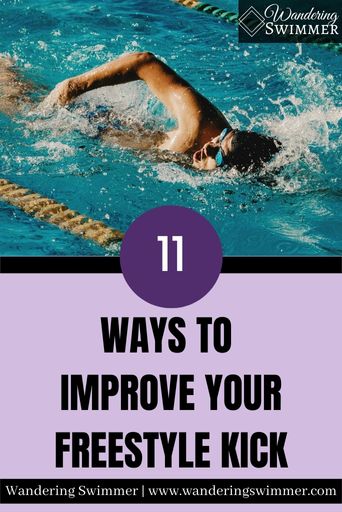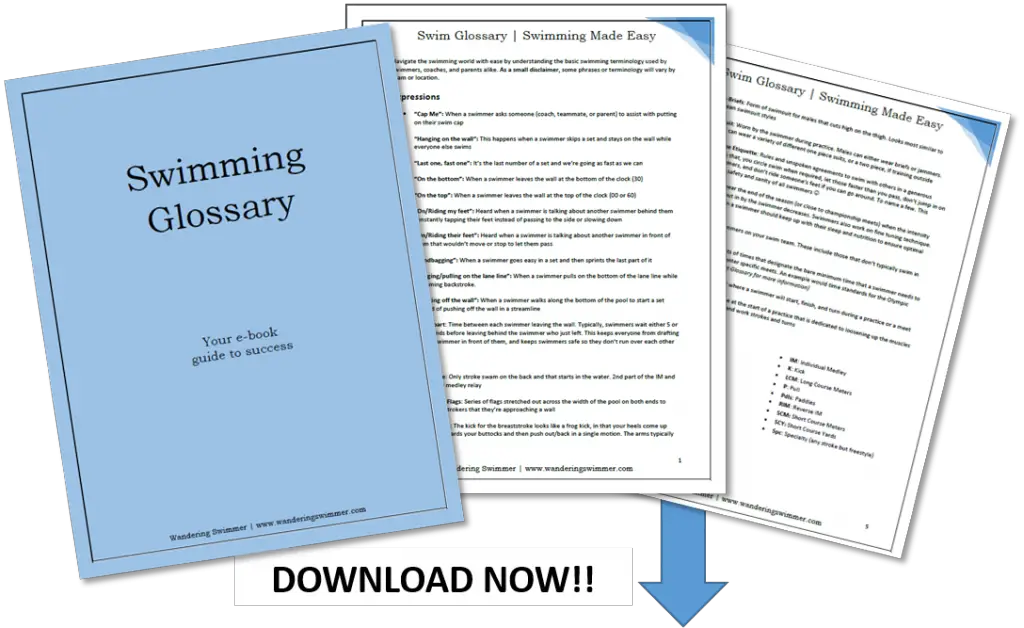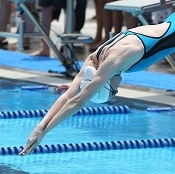Whether you’re a new swimmer just starting or a seasoned one, you can always improve your freestyle kick! Small adjustments can make a big difference for swimmers in either their workout or a race.
If you’re wanting to get a faster freestyle or have a better flutter kick, here are 11 ways to improve your freestyle kick.
Related article: How to Flutter Kick When Swimming Freestyle
Disclosure: This post may contain affiliate links, meaning we earn a small commission at no cost to you if you purchase something through one of our links. As an Amazon Associate, we earn from qualifying purchases. Please check out our disclosure page for more information

How to Improve Your Freestyle Kick
1. Start Kicking in the Water
It sounds silly, but the best way to improve your freestyle kick is to kick while swimming! If you’re the swimmer who has a slower flutter kick or doesn’t like to kick much, it’s tempting to avoid kicking altogether.
More Content for You: How Many Laps in a Pool is a Mile?
But avoiding the flutter kick in freestyle for your entire workout or practice isn’t the way to improve it. Instead, you need to set aside dedicated time in your workout to put in a short kick set. Or, you need to make yourself kick while you’re swimming.
Both options are the preferred method! 🙂
A proper flutter kick not only helps drive you forward in the water but also helps keep your stroke balanced. It’s also ideal to include in your freestyle stroke if you’re looking to take advantage of the full-body workout that swimming provides.
2. Ankle Flexibility
Your ankles play a much larger role in your kick than you realize and a lack of flexibility in them can make kicking more difficult. To improve this and your kick, you should try to get some flexibility in your ankles.
Do this by drawing a circle with your big toe. Both clockwise and counter clock. Try starting with at least 10 circles in each direction, for each leg. You can also flex your foot up and down so that it goes from a flat position to pointed toes.
Both of these will help give some flexibility to your ankles. And it can help improve not just your flutter kick, but other kicks, too!
While some individuals will suggest sitting on your ankles to help stretch your ankles, we’re not overly fond of the exercise. This stretch can be hard on the knees.
More Content for You: 7 Reasons to Wear Goggles When You Swim
3. Flutter Kick from Your Core and Hips
We’ve said it a dozen times before in other articles, but it bears repeating 😉 Your flutter kick should always start from your core and hips, not your knees! You’re swimming, not peddling a bicycle.
Kicking from your knees requires more effort and it’s an ineffective way of kicking. You won’t go anywhere or accomplish anything. Aside from exhausting yourself.
Your legs should stay just below the surface of the water. No part of them should ever dip down lower than your hips. Just as no part of your legs should exit the water when you’re kicking. Except for your feet, which we’ll cover later.
You should also watch that you’re not bending your knees so much that your leg from the knee and down is coming out of the water. The only thing this will accomplish is splashing a lot and making it look like you’re working hard. But you’re really not going anywhere.
More Content for You: Basic Pool Etiquette: 15 Ways to Share the Pool
Instead, keep your legs out straight behind you and focus on kicking from your hips and down through your thighs.
Follow your kick down to your toes, which should also be in a straight line behind you. Your knees will have only the slightest bend to them while you’re kicking.
4. Flex Your Ankles
Keep working your ankle flexibility because you need to flex your ankles to have a good freestyle kick.
Flexing your ankles while you kick not only helps improve your freestyle kick, but it’s also another way to help keep your legs straight.
When you flex your ankles/feet, you can feel and focus your kick through the length of your leg. From the top to the bottom. And you’re utilizing the full leg to complete your kick instead of just a portion.
It’s important to note that flexing your ankles isn’t the same as pointing your toes. Yes, your feet will be pointed some (you don’t want them completely vertical in the water when the rest of your body is horizontal).
But they shouldn’t be pointed in the same way a gymnast would point their feet. Doing this will make your feet cramp up and you probably want to avoid that 😉
Instead, let them flex slightly as you’re kicking. If you look down at your legs when you’re kicking, your feet should be straight out behind you. Not pointing down in the water. It’ll look like you’re pointing your toes even if you aren’t.
Related article: The 11 Best Kickboards for Swimmers
Flexing your ankles also has the benefit of reducing drag in the water or being aerodynamic. In swimming, the more aerodynamic you are in the water, the faster you can go and the easier it is to move through the water.
If you find that you have difficulty flexing your ankles when you’re kicking, work on your ankle rotations. We told you having flexible ankles is important for your kick!
You can also add fins to your workout, which will help your feet point while you kick. We will note that fins can cause your foot to cramp if you’re not used to them at first. Stop kicking with fins if your foot starts to cramp and work out the cramp before trying again.
5. Short and Shallow Kicks
Hand in hand with not bending your knees (yes, back with the knee bending!) but keep your flutter kick short and shallow. By this, we mean that your legs aren’t making deep, sweeping motions in the water.
Remember, your legs shouldn’t be dropping below your hips. At best, your kick shouldn’t go deeper than a foot under the water. Anything more than that is too deep and you’re wasting energy.
Related article: 5 Common Flutter Kick Mistakes to Avoid
Keeping a short and shallow kick will also keep you from kicking your feet/legs out of the water. As with large and deep kicks, you’re more tempted to kick your leg out of the water.
Instead, short and shallow is the way to go. This is especially true for a six-beat freestyle kick, where you’re kicking consistently. But even two-beat flutter kicks should stay shallow in their kick.
6. Don’t Bring Your Feet Out of the Water
When you kick in freestyle, your whole foot shouldn’t be coming out of the water. Chances are if your entire foot is exiting the water, you’re bending your knee too much. Instead, keep your kick short and shallow (as stated above) so that only your heel and/or toes leave the water.
And again, this is where ankle flexibility comes into play and has a large impact on your freestyle kick. Who knew ankles played such a large role in swimming?
More Content for You: How Many Calories Does Swimming Burn?
If you’re not sure if your feet leave the water when you’re kicking, have someone watch your kick. You may need to slow the kick down some if you do a six-beat kick. It may be a good idea to video the kick and slow it down that way.
It probably seems like something simple and for some, it’s an easy fix! But even that little fix to your flutter kick can improve your freestyle kick.
7. Find the Kick Pattern That Works for You
Everyone has a set kick pattern that they prefer. I favor a six-beat, constant kick. Others on my team lean towards a two-beat kick. And while we can switch between them as the race or set demands, it’s easier to stick with what’s familiar.
Don’t force yourself into a different kick pattern if it doesn’t work for you. As an example, a two-beat kick doesn’t work for my stroke style.
Even in distance events such as the mile (way back when I used to swim it), I would keep my kick going the entire race. Granted, it wouldn’t be as strong and forceful of a kick but my kick didn’t let up.
More Content for You:
My coach and I have tried a two-beat kick for distance events but it doesn’t work for me. Plain and simple as that. And that’s okay! Some can switch out as needed while others can’t. But you have to find what works for you.
And once you know what kick pattern works for you, start to work and improve it. Learn how to develop the kick so it’s stronger and faster. So that if you do a two-beat kick, you’re getting the most out of your kick. Or that you’re not burning out using a constant six-beat kick.
Can you play around with kicking patterns? Of course! It’s how you learn and improve in swimming. But if something isn’t working no matter what you do, it’s time to put that one to rest and work with what does work for you.
8. Kick Sets
This somewhat goes back to the number one way to improve your freestyle kick in that you have to start kicking to improve your kick. And not only do you have to start kicking but using structured kick sets is a great way to track your progress.
Kick sets are designated pieces in your workout that focus solely on kicking. It can include a board or fins if you so choose. Just as it can incorporate any style kick (flutter, dolphin, and breaststroke kick).
I’m partial to sets on intervals (timed sets), so I can track my progress and ensure the intensity is there. It can be something as simple as 8x50s with fins on 40 seconds. Or a bit more complex by changing the interval between odd and even numbers. Or even dropping the time for the last few numbers.
More Content for You:
Putting myself on a time ensures that I’m not just floating through the kick set. I’m actually working my kick, strengthening my leg muscles, and challenging myself to work harder and faster.
Does it work? For most swimmers, it can! I know my kick sets have gotten faster over the years. My times have dropped and improved, which translates into a faster kick when I incorporate the kick into my stroke.
Even adding a 300-yard/meter kick set to your workout is enough. Something small to get the straight focus on your kick can help you see improvements on your flutter kick.
9. Fin Work
Strapping on a pair of fins can make you feel as fast as a dolphin and let you fly through the water. If you’re using them correctly, of course. And, we’ll argue, if you’re using the correct swim fins.
Swim fins help develop your kick in terms of strength, speed, and technique. And if you’ve read our article: The 10 Best Swim Fins for Swimmers, you’ll know we’re not fans of the long-bladed, floating fins.
Cheater fins, as we call them at our pool.
They may be lightweight and make you go fast due to their design, but you do yourself a disservice by using them. You’re more likely to bend your knees due to the length of the fins.
And because the blades are so long, it’s not you that’s making yourself go faster. It’s all the fins. Whereas, if you use a shorter blade, the extra speed is due to the work you’re putting in with the fin on and not just the fin itself.
Related articles:
Using fins for your kick sets or kicking, in general, is also a good way to feel the water. You can feel the pressure of the water against your fins as you kick which allows you to find the right motions for kicking.
Fins can also help you identify too much knee bending! If you’re bending your hips to bring your knees up to your chest or trying to bicycle kick with them, your fins will catch the water, making it harder to kick.
They’ll also help you feel if your feet are leaving the water. Not just by the splash it creates but also by the sound and the pressure on your feet.
So while fins can be fun to use, they also serve as a great way to help you improve your freestyle kick. Use them at least once or twice a week to get the most out of their benefits 🙂
10. Back to Basics
It never hurts to take time to occasionally go back to the basics in kicking. Work in some flutter kicks drills to ensure you’re kicking correctly or if you need any corrections.
Drill work is important in swimming. Not just for the stroke as a whole but for the individual pieces too. Such as the kicking and pulling aspects.
Related article: 8 Flutter Kick Drills
Take the time to focus on these pieces with various drills to make sure you’re not getting complacent with your kick. That’s how issues with your stroke or kick can happen, and it’s easy to fall into bad, lazy habits.
11. Dryland Strength Training
A good kick doesn’t happen just in the water. It can also develop on land through strength training (dryland) and stretching.
Even adding a few sets of lunges or squats to your workout can help strengthen your leg muscles more to improve your freestyle kick. Because good technique can only go so far after a while. That’s where strength and weight training become an important piece to add to your training.
Don’t get us wrong, weights can be an important aspect to swimming. But we are also of the firm belief that correct technique is more important to your swimming than developing strength.
Related article: Why Competitive and Lap Swimmers Should Lift Weights
Your focus in strength training isn’t to bulk up your legs. Rather, it’s to help develop the muscle so it has the power and strength to kick faster as your kick improves. The two work together instead of one before the other.
You don’t need to squat mass amounts of weights or load up a leg machine either. Try bodyweight squats and lunges. And as you feel comfortable, add some lightweight if you feel it’s necessary.
In Closing
The flutter kick in freestyle is an important piece to continually develop, build, and improve on. Even if you don’t like kicking, taking the time to improve your freestyle kick by focusing on drills or kick sets can improve your freestyle as a whole.
As always, happy swimming!
Chevron
Bonus Content
7 Reasons Why is Swimming So Hard: There’s no way around it. Swimming can be challenging. From the technical aspect to the full-body workout, we’ll break down why swimming is so hard.
Basic Swimming Terminology: Knowing some swimming terminology, or swim terms, will help you navigate the swimming world. Here are 25 common swimming terms to get you started.

Want to Improve at the Pool?
Join swimmers and swim parents to receive my free newsletter and receive a free Swimming Glossary e-book as a thanks!
Every month you’ll receive tips and coaching to help you find success at the pool.
About

Chevron is a current competitive swimmer with almost 20 years of experience in the pool. And although she fell into the sport by accident in her high school years, she still trains daily and competes throughout the year. She’s committed to providing guidance to all levels of swimmers and believes that everyone should know how to swim.